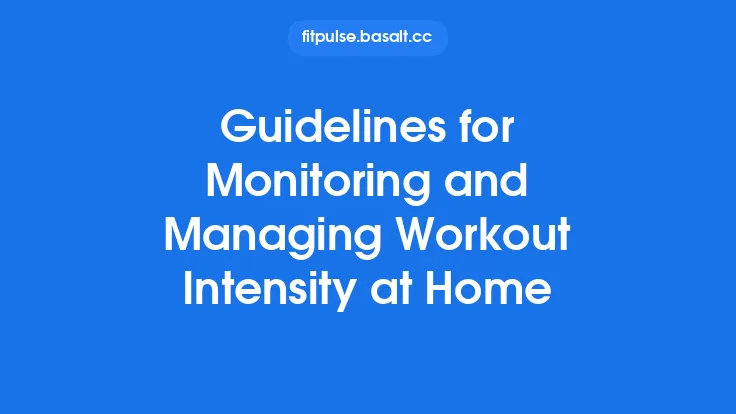When it comes to exercising at home, seniors often wonder how hard they should be working and when it’s safe to push a little farther. The answer lies in a systematic approach to monitoring and adjusting intensity—an ongoing conversation between the body, the mind, and the environment. By learning to read reliable signals, set realistic benchmarks, and make evidence‑based tweaks, older adults can enjoy the benefits of regular movement while minimizing the risk of injury or over‑exertion. The following guide walks through the essential concepts, practical tools, and step‑by‑step strategies that make intensity management both understandable and sustainable for seniors living independently.
Understanding Exercise Intensity for Seniors
Exercise intensity describes how much effort the body is expending during a workout. For older adults, intensity is not a one‑size‑fits‑all number; it is a relative measure that depends on cardiovascular fitness, muscular strength, joint health, medication effects, and daily energy levels. Two primary dimensions are commonly used:
| Dimension | What It Refers To | Typical Senior Considerations |
|---|---|---|
| Cardiovascular Load | Heart rate, oxygen consumption, breathing rate | Resting heart rate may be higher due to medications (e.g., beta‑blockers) or chronic conditions; target zones are often expressed as a percentage of age‑predicted maximum heart rate (220 – age) or heart rate reserve. |
| Muscular Load | Amount of weight, resistance, or body‑weight used; speed of movement | Joint pain, osteoarthritis, or limited range of motion may dictate lighter loads and slower tempos. |
Understanding these dimensions helps seniors decide which metric (or combination) best reflects their personal effort level.
Key Physiological Markers to Track
- Heart Rate (HR)
- Resting HR: Measured after waking, before getting out of bed. A stable resting HR provides a baseline for detecting changes in fitness or health.
- Exercise HR: During activity, aim for 40‑65 % of age‑predicted maximum for moderate intensity, or 65‑80 % for vigorous intensity—if cleared by a healthcare provider.
- Recovery HR: The speed at which HR returns to near‑resting levels after a bout of activity (e.g., a drop of 20‑30 bpm within the first minute) is a useful indicator of cardiovascular health.
- Blood Pressure (BP)
- While many seniors have hypertension, a sudden spike (> 20 mmHg systolic) during exercise may signal excessive load. Checking BP before and after a session can help calibrate intensity.
- Respiratory Rate (RR)
- A comfortable breathing rhythm that allows conversation (see “Talk Test”) is a practical proxy for moderate intensity. Rapid, shallow breathing suggests the need to back off.
- Perceived Exertion
- Subjective scales (e.g., Borg RPE 6‑20 or the 0‑10 “Modified RPE”) capture how hard the workout feels, integrating cardiovascular, muscular, and psychological stress.
- Muscle Fatigue & Joint Sensations
- A mild “burn” in the working muscles is normal; sharp pain, swelling, or prolonged stiffness are warning signs.
The Talk Test and Perceived Exertion Scales
Talk Test
- Low Intensity: Able to sing a song without pausing for breath.
- Moderate Intensity: Able to speak in full sentences, but not sing.
- Vigorous Intensity: Only able to speak a few words at a time.
Borg Rating of Perceived Exertion (RPE) 6‑20
- 6 = no exertion (rest)
- 9‑11 = light (easy walking)
- 12‑14 = somewhat hard (moderate)
- 15‑17 = hard (vigorous)
- 18‑20 = very hard (max effort)
For seniors, aiming for an RPE of 11‑13 during most home sessions provides a safe “moderate” zone that aligns with cardiovascular guidelines while allowing flexibility for day‑to‑day variations.
Using Simple Home Tools to Gauge Intensity
| Tool | How to Use | Senior‑Friendly Tips |
|---|---|---|
| Manual Pulse Check | Place two fingers on the radial artery (thumb side of wrist) and count beats for 15 seconds, then multiply by 4. | Practice during a calm moment; use a mirror or a partner for guidance initially. |
| Smartphone Heart‑Rate Apps | Many phones have built‑in cameras that detect pulse via fingertip. | Verify accuracy against a manual count; keep the phone steady. |
| Wearable Fitness Tracker | Tracks HR, steps, and sometimes RR. | Choose a device with a clear, large display and easy strap adjustment. |
| Stopwatch/Timer | Measures interval lengths, rest periods, and total session time. | Use a kitchen timer or a voice‑activated assistant (e.g., “Hey Siri, set a 30‑second timer”). |
| RPE Card | Print a simple 0‑10 scale and keep it visible during workouts. | Mark the current rating with a pen or sticky note after each set. |
These low‑tech or consumer‑tech options empower seniors to collect objective data without needing a gym‑based lab.
Establishing Baseline and Setting Realistic Goals
- Baseline Assessment (Week 1)
- Record resting HR and BP on three separate mornings.
- Perform a 5‑minute seated march or gentle arm circles while monitoring HR and RPE.
- Note any joint discomfort, dizziness, or shortness of breath.
- Goal Formulation
- SMART Goals: Specific, Measurable, Achievable, Relevant, Time‑bound.
- Example: “Walk in place for 10 minutes at an RPE of 12, three times per week, for the next four weeks.”
- Progress Checkpoints
- Re‑measure resting HR and BP after four weeks.
- Compare RPE for the same activity; a lower RPE at the same duration indicates improved fitness.
Progressive Overload: When and How to Increase Load
Progressive overload is the cornerstone of continued adaptation. For seniors, the principle is applied conservatively:
| Variable | Small Increment Example | Frequency of Change |
|---|---|---|
| Duration | Add 1‑2 minutes to a cardio segment (e.g., marching in place). | Every 1‑2 weeks, if RPE remains ≤ 13. |
| Repetitions | Increase from 8 to 10 reps per set for a seated arm press. | Every 2 weeks, provided no joint pain. |
| Resistance | Use a 0.5 kg (1 lb) heavier household item (e.g., a water bottle). | Every 3 weeks, after a successful tolerance test. |
| Tempo | Slow eccentric phase from 2 seconds to 3 seconds. | As needed to enhance muscle control. |
| Rest Interval | Reduce rest from 60 seconds to 45 seconds. | Only after consistent completion of sets without excessive fatigue. |
Safety First: Before any increase, perform a “tolerance test”—a single set at the new level while monitoring HR, RPE, and joint sensations. If the test stays within the target zone, the progression can be incorporated into the full session.
Adjusting Intensity on the Fly: Real‑Time Decision Making
Even with a plan, daily fluctuations (medication timing, sleep quality, weather) may demand on‑the‑spot adjustments. Follow this quick decision tree:
- Check RPE
- If RPE > 14 (hard) and you feel breathless, reduce intensity (shorten duration, lower resistance).
- If RPE < 9 (very light) and you feel energetic, increase slightly (add a minute or a few reps).
- Monitor HR
- If HR exceeds the upper limit of your target zone by > 10 bpm, pause and perform a slow breathing exercise until HR drops.
- Assess Joint Feedback
- Sharp pain → stop the movement, modify the range, or switch to a non‑impact alternative.
- Mild soreness → continue, but consider reducing load for the next set.
- Use the “Talk Test”
- If you cannot speak a sentence, dial back intensity immediately.
- Hydration & Temperature
- If you feel dizzy or overly warm, pause, sip water, and reassess before resuming.
Safety Red Flags and When to Scale Back
| Symptom | Immediate Action |
|---|---|
| Chest pain, pressure, or tightness | Stop, sit down, call emergency services if pain persists. |
| Sudden shortness of breath not relieved by rest | Stop, monitor, seek medical advice. |
| Dizziness or light‑headedness | Sit or lie down, hydrate, check BP. |
| Unusual swelling or joint locking | Cease the activity, apply ice if needed, consult a healthcare professional. |
| Persistent fatigue beyond normal post‑exercise soreness | Reduce session length or intensity for the next few days. |
Recognizing these signs early prevents escalation into more serious events.
Documenting Sessions for Long‑Term Monitoring
A simple logbook—paper or digital—captures trends that inform future adjustments:
| Date | Activity | Duration | HR (Start/Peak/End) | RPE | Notes (pain, meds, mood) |
|---|---|---|---|---|---|
| 10/01/2025 | Seated marching | 12 min | 78/112/84 | 12 | Took morning antihypertensive; felt good. |
| 10/03/2025 | Light dumbbell press | 8 min | 80/106/78 | 11 | Slight shoulder ache after 2nd set. |
Review the log weekly to spot patterns (e.g., consistently higher HR on days after a new medication) and adjust the program accordingly.
Integrating Technology Safely
- Wearables: Choose devices with FDA‑cleared heart‑rate sensors if possible. Set alerts for HR exceeding your target zone.
- Voice Assistants: Use them to start timers, play calming music, or ask for a “quick check” of the current time and remaining session length.
- Video Calls: Periodically schedule a virtual check‑in with a physiotherapist or trainer who can observe form and intensity cues.
- Data Privacy: Ensure any app used complies with HIPAA or local privacy regulations; avoid sharing personal health data on public platforms.
Technology should augment, not replace, personal awareness. Always cross‑verify device readings with manual checks, especially when starting a new program.
Creating a Personalized Intensity Plan
- Gather Baseline Data (resting HR, BP, RPE for a familiar activity).
- Define Target Zones (e.g., HR 95‑115 bpm for moderate cardio; RPE 11‑13).
- Select Core Activities (choose movements that are safe, enjoyable, and require minimal equipment).
- Structure Sessions:
- Warm‑up (5 min low‑intensity, HR +10 bpm).
- Main Set (20‑30 min, alternating cardio and strength blocks).
- Cool‑down (5 min gentle stretching, HR returning to within 5 bpm of baseline).
- Plan Progression: Add 5 % more time or load every 2‑3 weeks, contingent on staying within target zones.
- Schedule Review: Every 4‑6 weeks, reassess baseline metrics and adjust targets.
Bottom Line
Monitoring and adjusting intensity is not a complicated science reserved for elite athletes; it is a practical, everyday skill that empowers seniors to stay active, confident, and safe in their own homes. By combining simple physiological checks (heart rate, breathing, perceived exertion) with clear goal‑setting, progressive overload, and vigilant documentation, older adults can enjoy the full spectrum of benefits that regular movement offers—without compromising health or comfort. The key is consistency, self‑awareness, and a willingness to adapt the plan as the body’s signals evolve. With these tools in hand, a senior home workout becomes a sustainable, enjoyable part of daily life.





